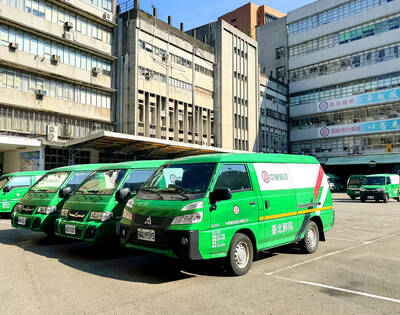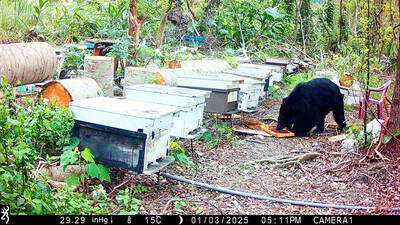The Environmental Protection Administration has called on New Year's Eve and Lunar New Year revelers to forgo firecrackers and fireworks this year and celebrate the holidays in a more environmentally friendly fashion.
"In addition to the physical danger posed by fireworks, the EPA advises against fireworks because they are harmful to human health as they release large amounts of heavy metal particles into the air," said Chang Shun-ching (張順欽), the EPA's department of environmental monitoring and information management senior specialist.
Chang cited the Yenshui Beehive Rockets (蜂炮) Festival in Yenshui Township (鹽水), Tainan County, saying that the administration's air quality evaluation last March showed the fireworks released more than 10 times the normal amount of baseline pollutants into the air.
The fine and coarse pollutants released into the air were potassium, aluminum, magnesium, barium, lead, strontium, calcium, sodium, iron and zinc, Chang said.
Strontium, potassium and barium were at 365, 182 and 147 times baseline density after the Yenshui celebrations, he said.
"People are advised to gauge their own health conditions before attending events that use fireworks, since the pollutants may trigger asthma attacks or other problems in those with weaker respiratory systems," he said.
In related news, dust coming from northeastern China would probably continue to cloud the nation's skies over the coming days, Chang said yesterday.
Although the dust cloud was forecast to subside yesterday or today, the public is advised to stay at home the next few days and avoid strenuous outdoor activity.
Children, the elderly and people with heart or respiratory conditions or compromised immune systems are especially affected by the dust, he said.

SHIPS, TRAINS AND AUTOMOBILES: The ministry has announced changes to varied transportation industries taking effect soon, with a number of effects for passengers Beginning next month, the post office is canceling signature upon delivery and written inquiry services for international registered small packets in accordance with the new policy of the Universal Postal Union, the Ministry of Transportation and Communications said yesterday. The new policy does not apply to packets that are to be delivered to China, the ministry said. Senders of international registered small packets would receive a NT$10 rebate on postage if the packets are sent from Jan. 1 to March 31, it added. The ministry said that three other policies are also scheduled to take effect next month. International cruise ship operators

HORROR STORIES: One victim recounted not realizing they had been stabbed and seeing people bleeding, while another recalled breaking down in tears after fleeing A man on Friday died after he tried to fight the knife-wielding suspect who went on a stabbing spree near two of Taipei’s busiest metro stations, Taipei Mayor Chiang Wan-an (蔣萬安) said. The 57-year-old man, identified by his family name, Yu (余), encountered the suspect at Exit M7 of Taipei Main Station and immediately tried to stop him, but was fatally wounded and later died, Chiang said, calling the incident “heartbreaking.” Yu’s family would receive at least NT$5 million (US$158,584) in compensation through the Taipei Rapid Transit Corp’s (TRTC) insurance coverage, he said after convening an emergency security response meeting yesterday morning. National

PLANNED: The suspect visited the crime scene before the killings, seeking information on how to access the roof, and had extensively researched a 2014 stabbing incident The suspect in a stabbing attack that killed three people and injured 11 in Taipei on Friday had planned the assault and set fires at other locations earlier in the day, law enforcement officials said yesterday. National Police Agency (NPA) Director-General Chang Jung-hsin (張榮興) said the suspect, a 27-year-old man named Chang Wen (張文), began the attacks at 3:40pm, first setting off smoke bombs on a road, damaging cars and motorbikes. Earlier, Chang Wen set fire to a rental room where he was staying on Gongyuan Road in Zhongzheng District (中正), Chang Jung-hsin said. The suspect later threw smoke grenades near two exits

The Forestry and Nature Conservation Agency yesterday launched a gift box to market honey “certified by a Formosan black bear” in appreciation of a beekeeper’s amicable interaction with a honey-thieving bear. Beekeeper Chih Ming-chen (池明鎮) in January inspected his bee farm in Hualien County’s Jhuosi Township (卓溪) and found that more than 20 beehives had been destroyed and many hives were eaten, with bear droppings and paw prints near the destroyed hives, the agency said. Chih returned to the farm to move the remaining beehives away that evening when he encountered a Formosan black bear only 20m away, the agency said. The bear